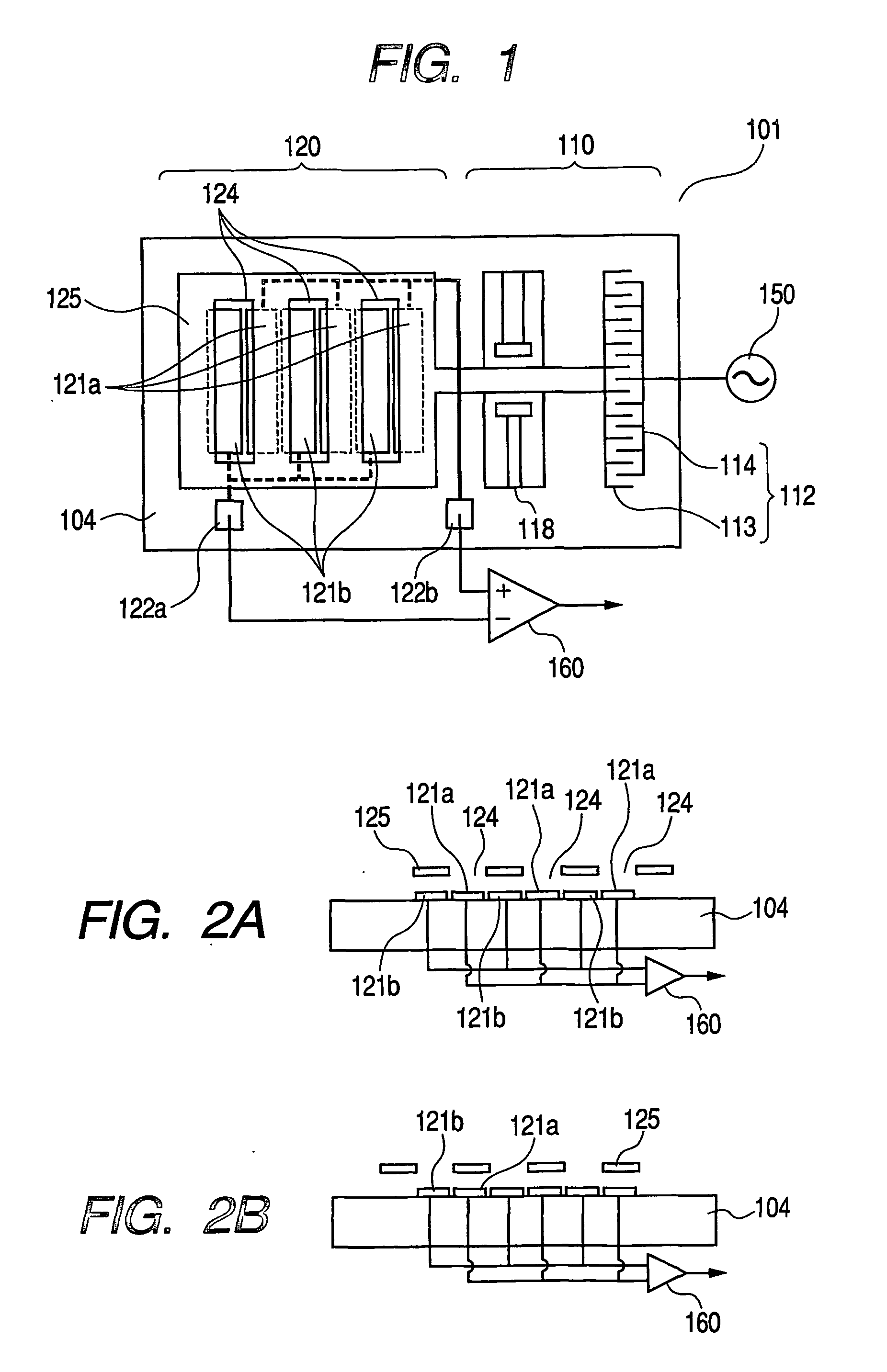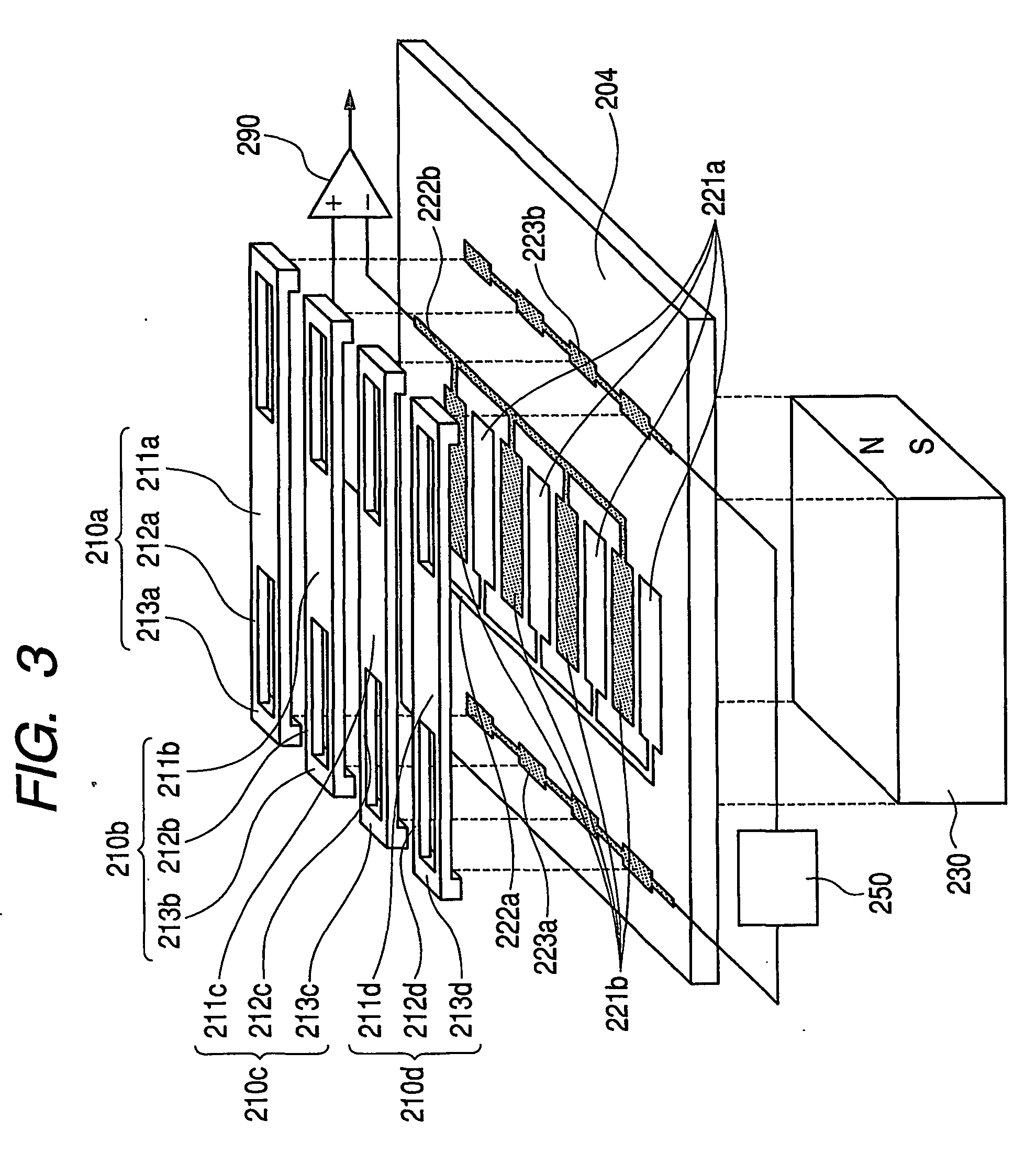Micromechanical potential sensor
a potential sensor and micro-mechanical technology, applied in the field of potential sensors, can solve the problems that the detection sensitivity cannot be made sufficiently high, and achieve the effects of improving the sensitivity, reducing the dimension, and increasing the area of the detection electrod
- Summary
- Abstract
- Description
- Claims
- Application Information
AI Technical Summary
Benefits of technology
Problems solved by technology
Method used
Image
Examples
example 1
[0029]FIG. 1 is a plan view of a potential sensor of Example 1, and FIGS. 2A and 2B are cross-sectional views thereof. A potential sensor 101 is formed by a driver component 110 and a sensor component 120. These are formed by a MEMS technology on a substrate 104.
[0030] The driver component 110 is formed by a suspension 118 having a parallel hinge structure, and a comb-shaped electrostatic actuator 112. The comb-shaped electrostatic actuator 112 is a common mechanism for electrostatically driving a micro structure, and is composed of a movable electrode 113 supported by the suspension 118 and a fixed electrode 114 mounted on the substrate 104. The comb-shaped electrostatic actuator 112 is electrically connected to an electrostatic drive signal source 150. The movable electrode 113 is supported by the suspension 118 so as to be movable in a lateral direction in the drawing. The comb-shaped electrodes of the movable electrode 113 and those of the fixed electrode 114 are mutually meshi...
example 2
[0037]FIG. 3 is an exploded perspective view of a potential sensor of an example 2. On a substrate 204, detection electrode assemblies 221a, 221b, lead electrodes 222a, 222b for detection electrodes, and driving lead electrodes 233a, 233b are formed by patterning. The detection electrode assemblies 221a, 221b are comprised of sets of mutually distanced individual detection electrodes, and the detection electrodes of each set are electrically connected by the lead electrode 222a or 222b for the detection electrodes. Also the individual detection electrodes of the detection electrode assemblies 221a, 221b are arranged with such gaps as not to cause electrical shortcircuiting. Movable shutter units 210a to 210d are formed by mask members 211a to 211d, parallel hinge suspensions 212a to 212d and fixed members 213a to 213d, which are integrally formed with conductive materials. In the present example, the driving lead electrodes 223a, 223b are fixedly coupled with the fixed members 213a ...
example 3
[0045]FIG. 5 is an exploded perspective view of a potential sensor of an example 3. On a substrate 204, detection electrode assemblies 321a, 321b, lead electrodes 322a, 322b for detection electrodes, connecting electrodes 323a to 323c, and driving lead electrodes 324a, 324b are formed by patterning. The detection electrode assemblies 321a, 321b are comprised of sets of mutually distanced individual detection electrodes, and the detection electrodes of each set are electrically connected by the lead electrode 322a or 322b for the detection electrodes. Also the individual detection electrodes of the detection electrode assemblies 321a, 321b are arranged with such gaps as not to cause electrical shortcircuiting. Movable shutter units 310a to 310d are formed by mask members 311a to 311d, parallel hinge suspensions 312a to 312d and fixed members 313a to 313d, which are integrally formed with conductive materials. The connecting electrodes 323a to 323c and the driving lead electrodes 324a...
PUM
 Login to View More
Login to View More Abstract
Description
Claims
Application Information
 Login to View More
Login to View More - R&D
- Intellectual Property
- Life Sciences
- Materials
- Tech Scout
- Unparalleled Data Quality
- Higher Quality Content
- 60% Fewer Hallucinations
Browse by: Latest US Patents, China's latest patents, Technical Efficacy Thesaurus, Application Domain, Technology Topic, Popular Technical Reports.
© 2025 PatSnap. All rights reserved.Legal|Privacy policy|Modern Slavery Act Transparency Statement|Sitemap|About US| Contact US: help@patsnap.com



